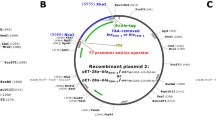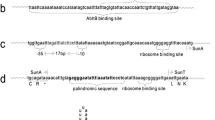Abstract
Chiral Vince lactam (γ-lactam) is an important precursor of many carbocyclic nucleoside analogues and pharmaceuticals. Here, a (+)-γ-lactamase encoding gene delm from Delftia sp. CGMCC 5755 was identified through genome hunting. To achieve its soluble and functional expression, Escherichia coli and Bacillus subtilis expression systems were introduced. Compared with E. coli system, recombinant (+)-γ-lactamase showed improved protein solubility and catalytic activity in B. subtilis 168. Reaction conditions for enantioselective resolution of γ-lactam were optimized to be at 30 °C, pH 9.0, and 300 rpm when employing the recombinant B. subtilis 168/pMA5-delm whole cells. Kinetic analysis showed that the apparent V max and K m were 0.595 mmol/(min · gDCW) and 378 mmol/L, respectively. No obvious substrate inhibition was observed. In a 500-mL reaction system, enantioselective resolution of 100 g/L γ-lactam was achieved with 10 g/L dry cells, resulting in 55.2 % conversion and 99 % ee of (−)-γ-lactam. All above suggested that recombinant B. subtilis 168/pMA5-delm could potentially be applied in the preparation of optically pure (−)-γ-lactam.








Similar content being viewed by others
References
Singh, R., & Vince, R. (2012). 2-azabicyclo 2.2.1 hept-5-en-3-one: chemical profile of a versatile synthetic building block and its impact on the development of therapeutics. Chemical Reviews, 112, 4642–4686.
Taylor, S. J. C., Mccague, R., Wisdom, R., Lee, C., Dickson, K., Ruecroft, G., Obrien, F., Littlechild, J., Bevan, J., Roberts, S. M., & Evans, C. T. (1993). Development of the biocatalytic resolution of 2-azabicyclo 2.2.1 hept-5-en-3-one as an entry to single-enantiomer carbocyclic nucleosides. Tetrahedron-Asymmetry, 4, 1117–1128.
Holt-Tiffin, K. E. (2009). (+)- and (−)-2-azabicyclo 2.2.1 hept-5-en-3-one extremely useful synthons. Chimica Oggi-Chemistry Today, 27, 23–25.
Toogood, H. S., Brown, R. C., Line, K., Keene, P. A., Taylor, S. J. C., Mccague, R., & Littlechild, J. A. (2004). The use of a thermostable signature amidase in the resolution of the bicyclic synthon (rac)-gamma-lactam. Tetrahedron, 60, 711–716.
Taylor, S. J. C., Brown, R. C., Keene, P. A., & Taylor, I. N. (1999). Novel screening methods—the key to cloning commercially successful biocatalysts. Bioorganic & Medicinal Chemistry, 7, 2163–2168.
Line, K., Isupov, M. N., & Littlechild, J. A. (2004). The crystal structure of a (−) gamma-lactamase from an Aureobacterium species reveals a tetrahedral intermediate in the active site. Journal of Molecular Biology, 338, 519–532.
Qin, X. X., Wang, J. J., & Zheng, G. J. (2010). Enantioselective resolution of gamma-lactam by a whole cell of Microbacterium hydrocarbonoxydans (L29-9) immobilized in polymer of PVA-Alginate-Boric acid. Applied Biochemistry and Biotechnology, 162, 2345–2354.
Ren, L., Zhu, S. Z., Shi, Y., Gao, S. H., & Zheng, G. J. (2015). Enantioselective resolutiiionnn of gamma-lactamase by a novel thermostable type II (+)-gamma-lactamase from the hyperthermophilic archaeon Aeropyrum pernix. Applied Biochemistry and Biotechnology. doi:10.1007/sl2010-015-1565-7.
Wang, J. J., Zhao, G., Zhang, Z., Liang, Q., Min, C., & Wu, S. (2014). Autodisplay of an archaeal gamma-lactamase on the cell surface of Escherichia coli using Xcc_Est as an anchoring scaffold and its application for preparation of the enantiopure antiviral drug intermediate (−)-vince lactam. Applied Microbiology and Biotechnology, 98, 6991–7001.
Zhu, S. Z., Ren, L., Yu, S. Z., Gong, C. Y., Song, D. W., & Zheng, G. J. (2014). Enzymatic preparation of optically pure (+)-2-azabicyclo 2.2.1 hept-5-en-3-one by (−)-gamma-lactamase from Bradyrhizobium japonicum USDA 6. Bioorganic & Medicinal Chemistry Letters, 24, 4899–4902.
Wang, J. J., Zhang, X., Min, C., Wu, S., & Zheng, G. J. (2011). Single-step purification and immobilization of γ-lactamase and on-column transformation of 2-azabicyclo [2.2. 1] hept-5-en-3-one. Process Biochemistry, 46, 81–87.
Wang, J. J., Zhu, J. G., Min, C., & Wu, S. (2014). CBD binding domain fused gamma-lactamase from Sulfolobus solfataricus is an efficient catalyst for (−) gamma-lactam production. BMC Biotechnology, 14, 40.
Wang, J. J., Zhu, J. G. & Wu, S. (2015). Immobilization on macroporous resin makes E. coli RutB a robust catalyst for production of (−)-Vince lactam. Applied Microbiology and Biotechnology, 99, 4691–4700.
Chen, H. G., Ni, Y., & Sun, Z. H. (2012). Isolation and fermentation optimization of a (+)-γ-lactamase-producing strain. China Biotechnology, 32, 41–47.
Wong, S. L. (1995). Advances in the use of Bacillus subtilis for the expression and secretion of heterologous proteins. Current Opinion in Biotechnology, 6, 517–522.
Dartois, V., Coppee, J., Colson, C., & Baulard, A. (1994). Genetic analysis and overexpression of lipolytic activity in Bacillus subtilis. Applied and Environmental Microbiology, 60, 1670–1673.
Chen, C. S., Fujimoto, Y., Girdaukas, G., & Sih, C. J. (1982). Quantitative analyses of biochemical kinetic resolutions of enantiomers. Journal of the American Chemical Society, 104, 7294–7299.
Sorensen, H. P., & Mortensen, K. K. (2005). Advanced genetic strategies for recombinant protein expression in Escherichia coli. Journal of Biotechnology, 115, 113–128.
De Marco, V., Stier, G., Blandin, S., & De Marco, A. (2004). The solubility and stability of recombinant proteins are increased by their fusion to NusA. Biochemical and Biophysical Research Communications, 322, 766–771.
Nishihara, K., Kanemori, M., Yanagi, H., & Yura, T. (2000). Overexpression of trigger factor prevents aggregation of recombinant proteins in Escherichia coli. Applied and Environmental Microbiology, 66, 884–889.
Zhu, S. Z., Gong, C. Y., Ren, L., Li, X. Z., Song, D. W., & Zheng, G. J. (2013). A simple and effective strategy for solving the problem of inclusion bodies in recombinant protein technology: His-tag deletions enhance soluble expression. Applied Microbiology and Biotechnology, 97, 837–845.
Tate, C. G., Haase, J., Baker, C., Boorsma, M., Magnani, F., Vallis, Y., & Williams, D. C. (2003). Comparison of seven different heterologous protein expression systems for the production of the serotonin transporter. Biochimica et Biophysica Acta-Biomembranes, 1610, 141–153.
Davis, G. D., Elisee, C., Newham, D. M., & Harrison, R. G. (1999). New fusion protein systems designed to give soluble expression in Escherichia coli. Biotechnology and Bioengineering, 65, 382–388.
Korf, U., Kohl, T., Van Der Zandt, H., Zahn, R., Schleeger, S., Ueberle, B., Wandschneider, S., Bechtel, S., Schnolzer, M., Ottleben, H., Wiemann, S., & Poustka, A. (2005). Large-scale protein expression for proteome research. Proteomics, 5, 3571–3580.
Hendrick, J. P., & Hartl, F. U. (1993). Molecular chaperone functions of heat-shock proteins. Annual Review of Biochemistry, 62, 349–384.
Nishihara, K., Kanemori, M., Kitagawa, M., Yanagi, H., & Yura, T. (1998). Chaperone coexpression plasmids: differential and synergistic roles of DnaK-DnaJ-GrpE and GroEL-GroES in assisting folding of an allergen of Japanese cedar pollen, Cryj2 in Escherichia coli. Applied and Environmental Microbiology, 64, 1694–1699.
Cui, S. S., Lin, X. Z., & Shen, J. H. (2011). Effects of co-expression of molecular chaperones on heterologous soluble expression of the cold-active lipase Lip-948. Protein Expression and Purification, 77, 166–172.
Haacke, A., Fendrich, G., Ramage, P., & Geiser, M. (2009). Chaperone over-expression in Escherichia coli: apparent increased yields of soluble recombinant protein kinases are due mainly to soluble aggregates. Protein Expression and Purification, 64, 185–193.
Li, W. F., Zhou, X. X., & Lu, P. (2004). Bottlenecks in the expression and secretion of heterologous proteins in Bacillus subtilis. Research in Microbiology, 155, 605–610.
Schallmey, M., Singh, A., & Ward, O. P. (2004). Developments in the use of Bacillus species for industrial production. Canadian Journal of Microbiology, 50, 1–17.
Moszer, I., Glaser, P., & Danchin, A. (1995). Subtilist- a relational database for the Bacillus subtilis genome. Microbiology-Uk, 141, 261–268.
Ni, Y., Zhang, B. H., & Sun, Z. H. (2012). Efficient synthesis of (R)-2-chloro-1-(3-chlorophenyl)ethanol by permeabilized whole-cells of Candida ontarioensis. Chinese Journal of Catalysis, 33, 681–687.
Laudani, C. G., Habulin, M., Knez, Z., Della Porta, G., & Reverchon, E. (2007). Immobilized lipase-mediated long-chain fatty acid esterification in dense carbon dioxide: bench-scale packed-bed reactor study. Journal of Supercritical Fluids, 41, 74–81.
Potumarthi, R., Ch, S., & Jetty, A. (2007). Alkaline protease production by submerged fermentation in stirred tank reactor using Bacillus licheniformis NCIM-2042: effect of aeration and agitation regimes. Biochemical Engineering Journal, 34, 185–192.
Liu, J. Y., Zheng, G. W., Imanaka, T., & Xu, J. H. (2014). Stepwise and combinatorial optimization of enantioselectivity for the asymmetric hydrolysis of 1-(3’,4’-methylenedioxyphenyl)ethyl acetate under use of a cold-adapted Bacillus amyloliquefaciens esterase. Biotechnology and Bioprocess Engineering, 19, 442–448.
Kurbanoglu, E. B., Zilbeyaz, K., Taskin, M., & Kurbanoglu, N. I. (2009). Total production of (R)-3,5-bistrifluoromethylphenyl ethanol by asymmetric reduction of 3,5-bis(trifluoromethyl)-acetophenone in the submerged culture of Penicillium expansum isolate. Tetrahedron-Asymmetry, 20, 2759–2763.
Acknowledgments
We are grateful to the National High Technology Research and Development Program of China (973 Program, 2011CB710800), National Natural Science Foundation of China (21276112, 31401634), the Fundamental Research Funds for the Central Universities (JUSRP51409B), the Program of Introducing Talents of Discipline to Universities (111-2-06), and a project funded by the Priority Academic Program Development of Jiangsu Higher Education Institutions for the financial support of this research.
Conflict of Interest
All the authors certify that this manuscript is original and has not been published and will not be submitted elsewhere for publication while being considered by Applied Microbiology and Biotechnology. And, the study is not split up into several parts to increase the quantity of submissions and submitted to various journals or to one journal over time. No data have been fabricated or manipulated (including images) to support your conclusions. No data, text, or theories by others are presented as if they were our own. The submission has been received explicitly from all co-authors. And, authors whose names appear on the submission have contributed sufficiently to the scientific work and therefore share collective responsibility and accountability for the results. The authors declare that they have no conflict of interest. This article does not contain any studies with human participants or animals performed by any of the authors. Informed consent was obtained from all individual participants included in the study.
Author information
Authors and Affiliations
Corresponding author
Electronic supplementary material
Below is the link to the electronic supplementary material.
ESM 1
(DOCX 111 kb)
Rights and permissions
About this article
Cite this article
Xue, TY., Xu, GC., Han, RZ. et al. Soluble Expression of (+)-γ-Lactamase in Bacillus subtilis for the Enantioselective Preparation of Abacavir Precursor. Appl Biochem Biotechnol 176, 1687–1699 (2015). https://doi.org/10.1007/s12010-015-1670-7
Received:
Accepted:
Published:
Issue Date:
DOI: https://doi.org/10.1007/s12010-015-1670-7




